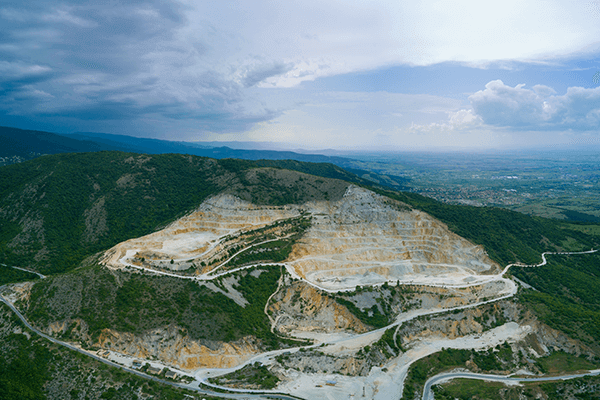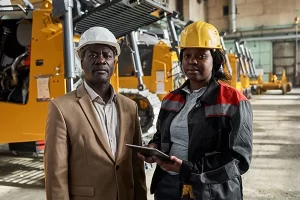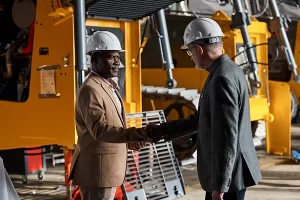Ores, salts or coal – mining and the raw materials extracted from the ground are a cornerstone of economic prosperity and technological progress. As we move toward a carbon-free energy future, three vital elements — carbon (in the form of graphite), cobalt and lithium — will need increased production.
Lithium-ion batteries are most famous for powering electric vehicles. The battery of a Tesla Model S, for example, uses around 12 kg of lithium. These batteries are the key to lightweight, rechargeable power. As it stands, demand for lithium is unprecedented, and many say it is crucial to transition to renewables. Whether lithium or mineral mining, the extraction of various mineral resources must be as environmentally compatible, safe and efficient as possible.
The mining industry is a vital part of the global economy, supplying essential raw materials for manufacturing and energy production. However, the industry has been facing new opportunities and challenges recently. Projects in the mining industry can be broken down into the exploration and feasibility stage and the planning and construction phase.
Exploration and Feasibility
The purpose of exploration is to find ores that are economically viable to mine. It begins with locating mineral anomalies, after which discovering and sampling confirm or deny that there is a find. Finally, it can be further proven through drilling programs and resource definition.
Planning and Construction
Once a potential mine is viable, the planning and construction phase begins with applying for and obtaining permits, continuing economic studies, and refining mine plans. Infrastructure development also occurs at this stage as mines are often located in remote areas that require the construction of roads and electricity.

Operating Mines
Once the operation is ready to begin, the asset officially becomes an operating mine. The ore is extracted, processed, and refined during this phase to produce metal. This section forms the bulk of the focus of the financial model for an operating mine. Once all the ore has been extracted, the mine closure process begins, which can last for several years. The process includes clean-up, reclamation, and environmental monitoring.
Future opportunities and challenges in the mining industry
Workforce
Mining and metals companies face their most significant talent shortage after a massive wave of retirements and resignations. Replacing these workers and finding talent with critical skills will require a radical rethink of the sector’s approach to attracting, retaining and nurturing talent.
Working in the mining industry requires many different skills. These skills are acquired through education, training and work experience.
Certain jobs in mining provide training on the job from day one, and many require qualifications, certifications or university courses in a discipline related to mining. Education and training can help career seekers get their foot in the door and obtain an entry-level position, or it can help them to advance their career and attain a higher position.
Productivity and costs
Managing variability through modelling and digital twins can help miners unlock sustainable savings. However, soaring inflation and talent costs significantly increase mining costs, squeezing productivity, and delaying expansion plans.
It is practically impossible to control the vicissitudes of the world’s economy that lead to shifts in currencies and commodities prices. But, miners can control the way they operate. As a result, companies are now focusing on reducing their mining operating costs and will have to move away from reactive cost-cutting methods and create sustainable programs for cost management. Here are some strategies to consider.
Managing costs needs to be done with an eye on long-term value and short-term gains. Sustainable cost reduction measures include, for example, switching to renewable energy, encouraging innovation to reduce costs in the longer term and creating strategic joint ventures to optimize economies of scale.
Health & Safety
Whether it’s open-pit or underground, mining is a risky business in terms of the health and safety of employees. The extractive industries have always been this way. The risks haven’t changed much over the decades and aren’t likely to over the long term. However, nowadays, the industry has a new approach to mitigating the likelihood of the risks: digitalization and connectivity. One example is geo-location tools that help organizations understand the immediate physical location of underground employees (using smartphones or wearables) with hazards such as large vehicles and gases. In addition, several companies are working to develop electric trolley systems to replace high-emission and noisy diesel systems.
Technological advancements in the mining industry
Considerable technological growth in the mining industry and the increasing need to refocus shared value achievement efforts have led to a rapid shift toward automation and other technological advances. This change is projected to increase productivity while lowering labour costs. New technological innovations in the mining industry have delivered ground-breaking benefits to the field over the years, such as:
Increased productivity:
Considerable technological growth in the mining industry and the increasing need to refocus shared value achievement efforts have led to a rapid shift toward automation and other technological advances. This change is projected to increase productivity while lowering labour costs. New technological innovations in the mining industry have delivered ground-breaking benefits to the field over the years, such as:
Maintenance optimization:
Technology has helped mines improve maintenance by conducting it on an as-needed basis instead of on a fixed schedule. It has also enabled workers to stay informed on maintenance history and work orders and even predict equipment failures before they occur.
Improved safety:
Automated mining technologies have improved job site safety by operating in dangerous working conditions, so miners don’t have to. Tools like smart sensors have also minimized the frequency of health and safety incidents and injuries.

Fewer operating costs:
In the mining industry, automated technologies have reduced labour and maintenance costs with continuous operation and less variability.
Minimized environmental harm:
Mining technologies have allowed workers to extract mining materials with minimal environmental impact. They have also led to reduced energy consumption.
Considering the future opportunities and challenges, the mining sector needs to foster innovation to remain competitive. Integrating technological innovation into its practices can result in reduced costs, increased productivity and improved worker safety for the mining sector.
If you’re thinking about how you can take your mining operations to the next level, give Field Eagle a try. Book a demo or a Pilot today, and see how easy it can be to digitize your operations.





